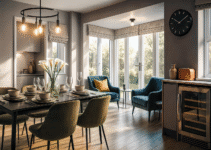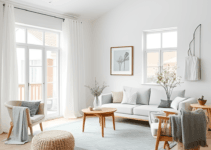Explore the essential role of color in creating serene environments within your home. Discover how whites and neutrals enhance tranquility and learn to integrate natural elements like wood and plants for a calming atmosphere. This guide provides tips on designing functional open spaces, transforming bedrooms into personal sanctuaries, and utilizing the psychological effects of color for optimal relaxation. Transform your living areas with thoughtful color palettes and natural materials to promote a peaceful retreat from daily life.
The Role of Color in Creating Serenity
The choice of color in interior design plays a pivotal role in establishing a serene atmosphere within a space. Specifically, the use of whites and neutrals can significantly enhance the ambiance, creating an illusion of openness and tranquility. These colors possess unique psychological effects, aiding in the reduction of stress and the promotion of clarity. Whites evoke a sense of purity and simplicity, while softer shades of beige and gray contribute to warmth and comfort. Together, they form a harmonious backdrop that can transform any area into a calming sanctuary.

Please read our article watch the newly uploaded video from our YouTube channel:
“Grig Stamate – Interior Design Solutions”
https://www.youtube.com/@GrigStamate
50 CALMING Interior Decor Solutions – White, Neutrals, and Natural Wood, #11 (video)
Here, you can see other related videos from our channel:
50 CALMING Interior Decor Solutions – White, Neutrals, and Natural Wood, #10 (video)
50 CALMING Interior Decor Solutions – White, Neutrals, and Natural Wood, #9 (video)
The calming nature of these hues can be particularly beneficial in spaces where relaxation is essential, such as bedrooms and living areas. For instance, a predominantly white palette can make a room feel spacious and airy, while strategically placed accents of beige can add depth and interest. When combining these colors, it is essential to consider the different shades available, as cooler whites can create a crisp, clean look, while warmer tones evoke a sense of coziness.
To create an effective color palette, consider the specific functions of each area in the home. In open spaces, a seamless blend of whites and neutrals can foster flow and connection, making the rooms feel cohesive and inviting. In contrast, a bedroom may benefit from slightly darker tones of beige or taupe, which can induce a sense of calm and manageability. When choosing paint colors, lighting should also be taken into account, as natural light can significantly alter the perception of colors throughout the day.
Ultimately, the strategic use of whites and neutrals can significantly enhance the serenity of your home. By thoughtfully selecting the right shades and combinations, one can create spaces that promote relaxation and provide a retreat from the busyness of everyday life.
Incorporating Natural Elements into Your Home
Integrating natural elements into your home décor can significantly enhance both warmth and tranquility, complementing the soothing aesthetics of white and neutral color schemes. Wood, in particular, is a versatile material that brings a unique richness to any space, owing to its various finishes and textures. From light woods like maple and birch to darker hues such as walnut and mahogany, the choice of wood types can create distinct atmospheres that contribute to a calming environment.
When selecting wooden finishes, consider options like matte, glossy, or distressed surfaces. Matte finishes lend a soft, understated elegance, while glossy wood can reflect light and create a sense of spaciousness. Distressed wood adds rustic charm, making it perfect for achieving a comforting ambiance. Incorporating wooden furniture pieces, such as coffee tables, dining chairs, or shelving units, can create harmony within your interior design, especially when these pieces are set against a backdrop of serene white or neutral tones.
In addition to wood, incorporating other natural materials can further elevate the calming effect of your interior. Stone accents in the form of countertops, wall cladding, or decorative elements can create a grounded feel within a room. Combining these surfaces with indoor plants introduces vibrant greenery, promoting a connection to nature that enhances relaxation. Consider selecting plant species that are known for their air-purifying qualities, such as peace lilies or snake plants, to create a refreshing atmosphere.
Textiles made from natural fibers such as cotton, linen, or jute can soften spaces and add a layer of comfort. Incorporating soft throws, plush cushions, and woven rugs can help tie together the different natural elements, creating an inviting, serene environment. Essential design elements like exposed wood beams or strategically placed wooden sculptures can act as focal points, drawing the eye while contributing to a tranquil space. By thoughtfully integrating these elements, you can achieve a balanced and calming interior that embraces the beauty of nature.
Designing Functional and Calming Open Spaces
Creating a calming environment in open spaces, particularly in living and dining areas, is essential for promoting relaxation and facilitating social interactions. An effective approach involves designing these spaces to balance functionality with a serene aesthetic. To achieve this, it is important to consider furniture arrangements that foster communication while also allowing for comfortable movement.
One effective strategy is to place seating arrangements in a circular or semi-circular layout. This arrangement enhances conversation flow and creates an inviting atmosphere. Opting for furniture with soft lines and neutral tones further contributes to a calming effect. Sofas and chairs upholstered in fabrics like linen or cotton in shades of white or light beige can invoke a sense of tranquility, while also emphasizing the minimalist approach that underpins a serene home environment.
In addition to thoughtful furniture placement, zoning is a critical element in designing open spaces. Utilizing decor and plants can visually delineate areas. For instance, a row of potted greenery can serve as a natural divider between the living and dining spaces, effectively demarcating function without sacrificing openness. Indoor plants not only enhance aesthetics but also improve air quality, reinforcing the tranquil ambiance.
Moreover, choosing furnishings that prioritize comfort while maintaining a minimalist aesthetic is crucial. Attention to detail in selecting these pieces can prevent the space from feeling cluttered. Consider using a simple dining table with sculptural chairs that reflect natural wood finishes. This combination harmonizes with the overall design ethos of using white, neutral palettes, and wood accents to create serene environments.
Case studies of well-designed open spaces highlight how these elements come together cohesively. Spaces that integrate white walls, natural light, and carefully curated furnishings cultivate a sense of calm. The design encourages relaxation while inviting social engagement, embodying the essence of a peaceful home.
Transforming Bedrooms into Personal Sanctuaries
A bedroom should serve as a retreat, a tranquil space where one can unwind and rejuvenate. To achieve this, incorporating white and neutral tones can significantly enhance the calming atmosphere of the environment. Drawing from elements of nature, the use of soft hues alongside natural wood finishes creates a harmonious interplay that fosters relaxation. Selecting bedding in subdued colors, such as light grays or gentle beiges, not only contributes to the serene ambiance but also promotes comfort and a good night’s sleep.
Wall colors are another vital component in establishing a peaceful bedroom. Opting for shades of white, pale blues, or soft greens helps reflect light and create an airy feel. These colors work well with wooden accents, such as furniture crafted from light oak or pine, which add warmth without overwhelming the space. The furniture layout should be designed to facilitate ease of movement, ensuring that there is a natural flow that further enhances the sense of calm.
Lighting also plays an essential role in how we experience our bedrooms. Soft, adjustable lighting options, such as dimmable fixtures or bedside lamps with warm-toned bulbs, contribute significantly to a soothing environment. Additionally, incorporating sensory elements such as fragrant essential oils or calming sound machines can transform the atmosphere, enriching the bedroom experience. Integrating storage solutions, such as under-bed storage or decorative baskets, allows for a clutter-free space, promoting tranquility through organization.
Ultimately, personalizing one’s bedroom with decor accents that resonate emotionally contributes to the concept of a sanctuary. Soft textiles, inspirational artwork, and cherished decorative items evoke positive feelings that further enhance serenity. By thoughtfully combining these elements, one can create a space that not only emphasizes aesthetics but also nurtures rest and relaxation, making bedrooms ideal havens for sleep and rejuvenation.
Other related posts from our website:
Let’s see here, three of them:
https://howtobuildahouseblog.com/sleek-and-serene-fabulous-modern-minimalist-interiors/
https://howtobuildahouseblog.com/turn-your-small-bedroom-into-a-serene-space-with-these-ideas/
We also sincerely hope you like our ideas from this post, and you have also enjoyed our uploaded YouTube video.
See you next time at another article.
Thank you so much for your time. Bye now!



No Responses